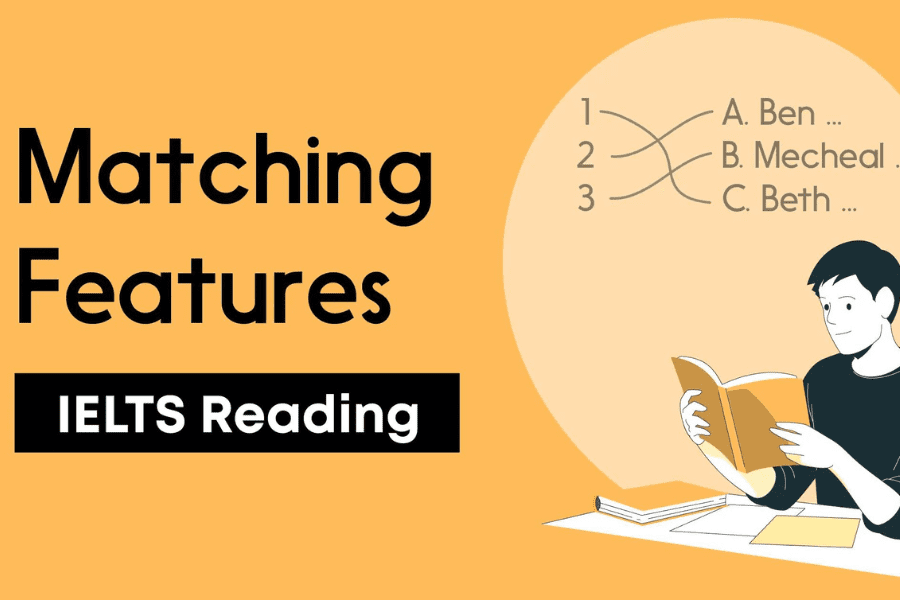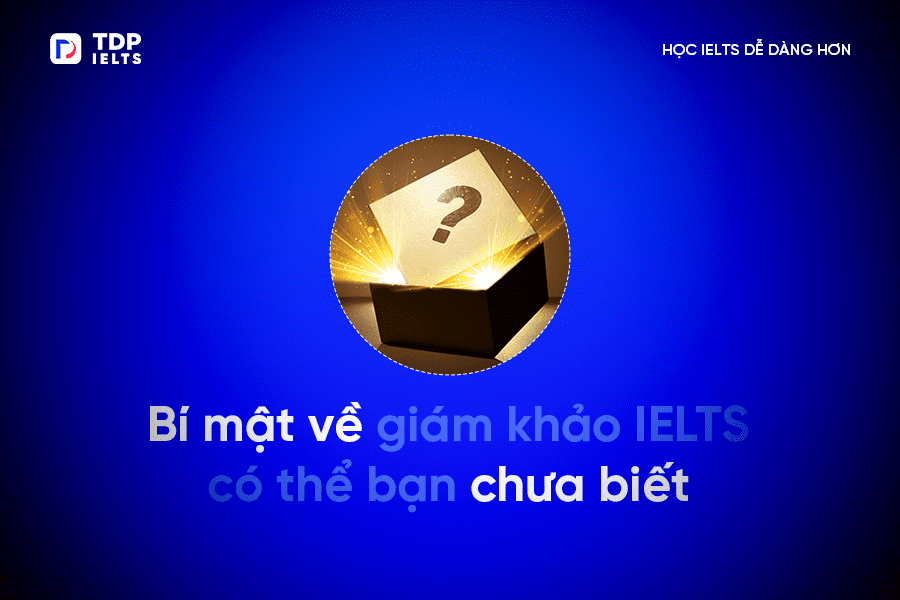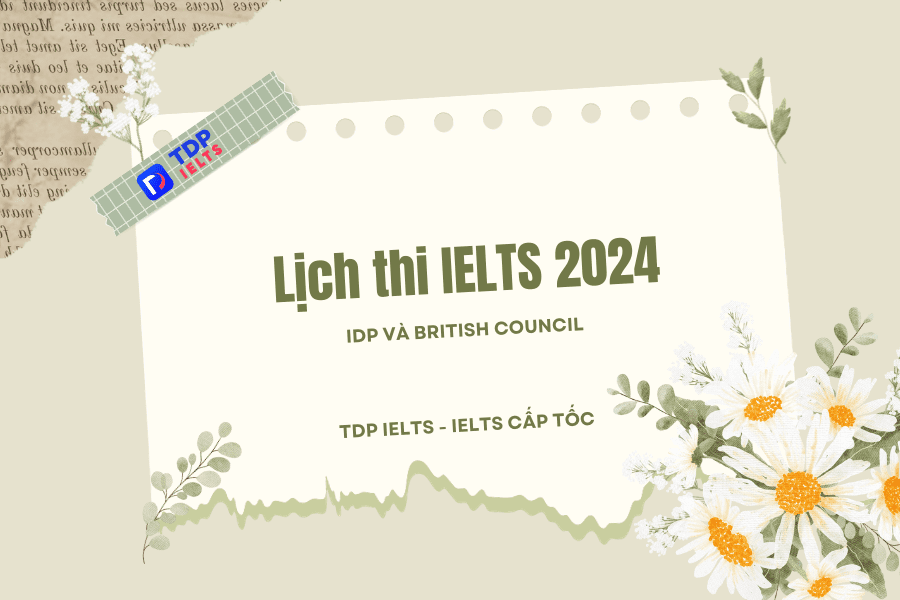Có bạn nào từng vật vã với dạng bài Matching Features trong IELTS Reading test? TDP IELTS sẽ giúp bạn một tay để nắm rõ chiến thuật làm dạng bài IELTS Reading này.

Nội dung
ToggleIELTS Reading Matching Features tips – Chiến thuật làm bài
Đối với bài IELTS Reading Matching Features, đề bài sẽ yêu cầu bạn nối các đối tượng trong một danh sách (tên nhà nghiên cứu, tên quốc gia, mốc thời gian…) với các thông tin tương ứng.
Đọc kỹ đề bài IELTS Reading Matching Features test
Bước 1: Đọc kỹ đề bài.
– Đôi lúc đề chỉ cho 4 lựa chọn (A, B, C, D) nhưng lại có đến 6 câu hỏi, nghĩa là sẽ có ít nhất một lựa chọn lặp lại 2 lần.
– Đề bài sẽ hướng dẫn rõ phần này bằng câu “NB You can use any letter more than once”.
Khoanh vùng câu trả lời
Bước 2: Khoanh vùng câu trả lời.
– Đọc cả câu hỏi lẫn danh sách các lựa chọn. Xác định các từ khóa.
– Gạch chân/khoanh tròn những tên riêng/mốc thời gian trong bài. Có thể dùng những ký hiệu khác nhau cho từng tên khác nhau để dễ phân biệt khi đọc.
Tips: Những tên riêng có thể được nhắc lại dưới dạng ngắn hơn (chỉ có họ/tên) hoặc thay thế bằng các đại từ (he/she/they).
Phân tích features và xác định thông tin đề cập
Bước 3: Bắt đầu với những features (tên/năm) chỉ xuất hiện một lần trong bài. Đọc kỹ xung quanh từng feature và xác định thông tin nó đề cập tới.
Phân tích câu hỏi và chọn câu trùng thông tin
Bước 4: Đọc kỹ các câu hỏi và chọn câu trùng khớp với thông tin vừa tìm thấy trong bài nhất.
Chọn đáp án
Bước 5: Chọn đáp án và lặp lại các bước trên.
Xem thêm: Bỏ túi cách viết Kết bài – Conclusion IELTS Writing Task 2
Bài tập mẫu Matching Features
Maths shows why words persist over time
In a finding that parallels the evolution of genes, researchers have shown that the more frequently a word is used, the less likely it is to change over long periods of time.
The question of why some words evolve rapidly through time while others are preserved – often with the same meaning in multiple languages has long plagued linguists. Two independent teams of researchers have tackled this question from different angles, each arriving at a remarkably similar conclusion.
“The frequency with which specific words are used in everyday language exerts a general and law-like influence on their rates of evolution,” writes Mark Pagel, author of one of two studies published this week.
Anyone who has tried to learn English will have been struck by its excess of stubbornly irregular verbs, which render grammatical rules unreliable. The past tense of regular verbs is formed by adding the suffix ‘-ed’, but this luxury is not afforded to their irregular kin. Over time, however, some irregular verbs ‘regularise’. For instance, the past tense of ‘help’ used to be ‘holp’, but now it is ‘helped.
Mathematician Erez Lieberman, from Harvard University in Massachusetts, US, performed a quantitative study of the rate at which English verbs such as ‘help’ have become more regular with time. Of the list of 177 irregular verbs they took from Old English, only 98 are still irregular today. Amazingly, the changes they observed obey a very precise mathematical description: the half-life of an irregular verb is proportional to the square root of its frequency. In other words, they found that the more an irregular verb is used, the longer it will remain irregular.
A separate group of academics, led by evolutionary biologist Mark Pagel from the University of Reading, in the UK, used a statistical modelling technique to study the evolution of words from 87 different Indo-European languages.
“Throughout its 8,000-year history, all Indo-European-language speakers have used a related sound to communicate the idea of ‘two’ objects – duo, due, deux, dos, etc.” Pagel commented. “But,” he adds, “there are many different and unrelated sounds for the idea of, for example, a bird – uccello, oiseau, pouli, pajaro, vogel, etc.”
Before now, however, nobody had proposed a mechanism for why some words should evolve more quickly than others. According to Pagel, “our research helps us to understand why we can still understand bits of Chaucer (a medieval poet]” and points out that this likely explains “why we can instinctively recognise words in other Indo-European languages, just from their sounds”.
Psychologist and language expert Russell Gray, from the University of Auckland in New Zealand, was impressed by both findings.
“Despite all the vagaries and contingencies of human history, it seems that there are remarkable regularities in the processes of language change,” he commented.
Hướng dẫn chi tiết IELTS Reading Matching Features questions
| Bước | Cách làm | Giải thích |
| Bước 1: Đọc kỹ đề bài. | Đề bài yêu cầu nối TÊN của các nhà nghiên cứu
Có 3 tên và 5 câu hỏi Có note “NB You may use any letter more than once” – một đáp án có thể xuất hiện 2 lần |
Đọc kỹ các yêu cầu để nắm rõ task cần làm |
| Bước 2: Khoanh vùng câu trả lời.
– Đọc câu hỏi. Xác định các từ khóa. – Gạch chân/khoanh tròn những tên riêng/mốc thời gian trong bài. |
1 We are able to recognise certain words used by people in other cultures.
2 Regardless of what happens in the world, there appear to be fixed rules that govern the way words alter over time. 3 Words that don’t follow a standard pattern will remain that way if they are used often. 4 Certain words have kept a similar sound across many years and many countries. 5 We focused on the historical changes that have occurred in one particular language. |
Các tên riêng đã được gạch chân trong bài. Từ khóa trong câu hỏi đã được gạch chân. |
| Bước 3: Bắt đầu với những features (tên/năm) chỉ xuất hiện một lần trong bài. Đọc kỹ xung quanh từng feature và xác định thông tin nó đề cập tới. | Scan kỹ các tên trong bài, ta thấy tên Russell Gray chỉ xuất hiện một lần ở cuối bài → đọc và loại tên này trước
Psychologist and language expert Russell Gray, from the University of Auckland in New Zealand, was impressed by both findings. “Despite all the vagaries and contingencies of human history, it seems that there are remarkable regularities in the processes of language change,” he commented. |
|
| Bước 4: Đọc kỹ các câu hỏi và chọn câu trùng khớp với thông tin vừa tìm thấy trong bài nhất. | Đọc lại các câu hỏi, ta thấy câu 2 có nhiều điểm tương đồng nhất:
2 Regardless of what happens in the world, there appear to be fixed rules that govern the way words alter over time.
→ Sau khi tìm ra câu trả lời, ta có thể loại tên C ra khỏi danh sách lựa chọn. |
Từ khóa:
– despite = regardless of – vagaries and contingencies = what happens – remarkable regularities = fixed rules – processes of language change = govern the way words alter over time → Đáp án đúng: 2 C |
| Bước 5: Chọn đáp án và lặp lại các bước trên. | Đọc xung quanh tên Pagel, đối chiếu và lọc ra các thông tin liên quan đến câu hỏi:
According to Pagel, “our research … points out that this likely explains “why we can instinctively recognise words in other Indo-European languages, just from their sounds”. → 1 We are able to recognise certain words used by people in other cultures. “Throughout its 8,000-year history, all Indo-European-language speakers have used a related sound to communicate the idea of ‘two’ objects – duo, due, deux, dos, etc.” Pagel commented. → 4 Certain words have kept a similar sound across many years and many countries. |
Từ khóa:
– can = are able to – recognise words = recognise certain words – other Indo-European languages = other culture
→ Đáp án đúng: 1 A
– 8,000 years = many years – certain words = “two” – similar = related – many countries = all Indo-European speakers
→ Đáp án đúng: 4 A |
| Đọc xung quanh tên Lieberman, đối chiếu và lọc ra các thông tin liên quan đến câu hỏi:
Mathematician Erez Lieberman, from Harvard University in Massachusetts, US, performed a quantitative study of the rate at which English verbs such as ‘help’ have become more regular with time. Of the list of 177 irregular verbs they took from Old English, only 98 are still irregular today. Amazingly, the changes they observed obey a very precise mathematical description: the half-life of an irregular verb is proportional to the square root of its frequency. In other words, they found that the more an irregular verb is used, the longer it will remain irregular. 3 Words that don’t follow a standard pattern will remain that way if they are used often. 5 We focused on the historical changes that have occurred in one particular language.
|
Từ khóa câu 3:
– don’t follow/standard pattern = irregular – remain that way = remain irregular – the more…is used = used often
→ Đáp án đúng: 3 B
– focus = perform a study – historical changes = old English/today – one language = English
→ Đáp án đúng: 5 B |
Matching Features IELTS practice – Luyện tập chi tiết với đề mẫu
Cùng luyện các đề IELTS Reading Matching Features exercises với TDP IELTS nhé!
Practice test 11
Why Pagodas Don’t Fall Down
(Excerpt)
Yet in 826, with only pegs and wedges to keep his wooden structure upright, the master builder Kobodaishi had no hesitation in sending his majestic Toji pagoda soaring fifty-five metres into the sky – nearly half as high as the Kasumigaseki skyscraper built some eleven centuries later. Clearly, Japanese carpenters of the day knew a few tricks about allowing a building to sway and settle itself rather than fight nature’s forces. But what sort of tricks?
The multi-storey pagoda came to Japan from China in the sixth century. As in China, they were first introduced with Buddhism and were attached to important temples. The Chinese built their pagodas in brick or stone, with inner staircases, and used them in later centuries mainly as watchtowers. When the pagoda reached Japan, however, its architecture was freely adapted to local conditions – they were built less high, typically five rather than nine storeys, made mainly of wood and the staircase was dispensed with because the Japanese pagoda did not have any practical use but became more of an art object. Because of the typhoons that batter Japan in the summer, Japanese builders learned to extend the eaves of buildings further beyond the walls. This prevents rainwater gushing down the walls. Pagodas in China and Korea have nothing like the overhang that is found on pagodas in Japan.
The roof of a Japanese temple building can be made to overhang the sides of the structure by fifty per cent or more of the building’s overall width. For the same reason, the builders of Japanese pagodas seem to have further increased their weight by choosing to cover these extended eaves not with the porcelain tiles of many Chinese pagodas but with much heavier earthenware tiles.
[…]
Another strange feature of the Japanese pagoda is that, because the building tapers, with each successive floor plan being smaller than the one below, none of the vertical pillars that carry the weight of the building is connected to its corresponding pillar above. In other words, a five- storey pagoda contains not even one pillar that travels right up through the building to carry the structural loads from the top to the bottom. More surprising is the fact that the individual storeys of a Japanese pagoda, unlike their counterparts elsewhere, are not actually connected to each other. They are simply stacked one on top of another like a pile of hats. Interestingly, such a design would not be permitted under current Japanese building regulations.
Classify the following as typical of
| A both Chinese and Japanese pagodas
B only Chinese pagodas C only Japanese pagodas |
Write the correct letter, A, B or C
- easy interior access to top
- tiles on eaves
- use as observation post
- size of eaves up to half the width of the building
- original religious purpose
- floors fitting loosely over each other
Practice test 12
A Chronicle of Timekeeping
A
According to archaeological evidence, at least 5,000 years ago, and long before the advent of the Roman Empire, the Babylonians began to measure time, introducing calendars to co-ordinate communal activities, to plan the shipment of goods and, in particular, to regulate planting and harvesting. They based their calendars on three natural cycles: the solar day, marked by the successive periods of light and darkness as the earth rotates on its axis; the lunar month, following the phases of the moon as it orbits the earth; and the solar year, defined by the changing seasons that accompany our planet’s revolution around the sun.
B
Before the invention of artificial light, the moon had greater social impact. And, for those living near the equator in particular, its waxing and waning was more conspicuous than the passing of the seasons. Hence, the calendars that were developed at the lower latitudes were influenced more by the lunar cycle than by the solar year. In more northern climes, however, where seasonal agriculture was practised, the solar year became more crucial. As the Roman Empire expanded northward, it organised its activity chart for the most part around the solar year.
C
Centuries before the Roman Empire, the Egyptians had formulated a municipal calendar having 12 months of 30 days, with five days added to approximate the solar year. Each period of ten days was marked by the appearance of special groups of stars called decans. At the rise of the star Sirius just before sunrise, which occurred around the all-important annual flooding of the Nile, 12 decans could be seen spanning the heavens. The cosmic significance the Egyptians placed in the 12 decans led them to develop a system in which each interval of darkness (and later, each interval of daylight) was divided into a dozen equal parts. These periods became known as temporal hours because their duration varied according to the changing length of days and nights with the passing of the seasons. Summer hours were long, winter ones short; only at the spring and autumn equinoxes were the hours of daylight and darkness equal. Temporal hours, which were first adopted by the Greeks and then the Romans, who disseminated them through Europe, remained in use for more than 2,500 years.
D
In order to track temporal hours during the day, inventors created sundials, which indicate time by the length or direction of the sun’s shadow. The sundial’s counterpart, the water clock, was designed to measure temporal hours at night. One of the first water clocks was a basin with a small hole near the bottom through which the water dripped out. The falling water level denoted the passing hour as it dipped below hour lines inscribed on the inner surface. Although these devices performed satisfactorily around the Mediterranean, they could not always be depended on in the cloudy and often freezing weather of northern Europe.
E The advent of the mechanical clock meant that although it could be adjusted to maintain temporal hours, it was naturally suited to keeping equal ones. With these, however, arose the question of when to begin counting, and so, in the early 14th century, a number of systems evolved. The schemes that divided the day into 24 equal parts varied according to the start of the count: Italian hours began at sunset, Babylonian hours at sunrise, astronomical hours at midday and ‘great clock’ hours, used for some large public clocks in Germany, at midnight. Eventually these were superseded by ‘small clock’, or French, hours, which split the day into two 12-hour periods commencing at midnight.
F
The earliest recorded weight-driven mechanical clock was built in 1283 in Bedfordshire in England. The revolutionary aspect of this new timekeeper was neither the descending weight that provided its motive force nor the gear wheels (which had been around for at least 1,300 years) that transferred the power; it was the part called the escapement. In the early 1400s came the invention of the coiled spring or fusee which maintained constant force to the gear wheels of the timekeeper despite the changing tension of its mainspring. By the 16th century, a pendulum clock had been devised, but the pendulum swung in a large arc and thus was not very efficient.
G
To address this, a variation on the original escapement was invented in 1670, in England. It was called the anchor escapement, which was a lever-based device shaped like a ship’s anchor. The motion of a pendulum rocks this device so that it catches and then releases each tooth of the escape wheel, in turn allowing it to turn a precise amount. Unlike the original form used in early pendulum clocks, the anchor escapement permitted the pendulum to travel in a very small arc. Moreover, this invention allowed the use of a long pendulum which could beat once a second and thus led to the development of a new floor standing case design, which became known as the grandfather clock.
H
Today, highly accurate timekeeping instruments set the beat for most electronic devices. Nearly all computers contain a quartz-crystal clock to regulate their operation. Moreover, not only do time signals beamed down from Global Positioning System satellites calibrate the functions of precision navigation equipment, they do so as well for mobile phones, instant stock-trading systems and nationwide power-distribution grids. So integral have these time-based technologies become to day-to-day existence that our dependency on them is recognised only when they fail to work.
Look at the following events (Questions 5-8) and the list of nationalities below. Match each event with the correct nationality, A-F.
- A Babylonians
- B Egyptians
- C Greeks
- D English
- E Germans
- F French
- They devised a civil calendar in which the months were equal in length.
- They divided the day into two equal halves.
- They developed a new cabinet shape for a type of timekeeper.
- They created a calendar to organise public events and work schedules.
Practice test 13
Venus in Transit
June 2004 saw the first passage., known as a ‘transit’ of the planet Venus across the face of the Sun in 122 years. Transits have helped shape our view of the whole Universe, as Heather Cooper and Nigel Henbest explain
A
On 8 June 2004, more than half the population of the world were treated to a rare astronomical event. For over six hours, the planet Venus steadily inched its way over the surface of the Sun. This “transit` of Venus was the first since 6 December l882. On that occasion, the American astronomer Professor Simon Newcomb led a party to South Africa to observe the event. They were based at a girls’ school, where – if is alleged – the combined forces of three schoolmistresses outperformed the professionals with the accuracy of their observations.
B
For centuries, transits of Venus have drawn explorers and astronomers alike to the four corners of the globe. And you can put it all down to the extraordinary polymath Edmond Halley. In November 1677, Halley observed a transit of the innermost planet Mercury, from the desolate island of St Helena in the South Pacific. .He realized that from different latitudes, the passage of the planet across the Sun’s disc would appear to differ. By timing the transit from two widely-separated locations, teams of astronomers could calculate the parallax angle – the apparent difference in position of an astronomical body due to a difference in the observer’s position. Calculating this angle would allow astronomers to measure what was then the ultimate goal; the distance of the Earth from the Sun. This distance is known as the ‘astronomical unit` or AU.
C
Halley was aware that the AU was one of the most fundamental of all astronomical measurements. Johannes Kepler, in the early 17*h century, had shown that the distances of the planets from the Sun governed their orbital speeds, which were easily measurable. But no-one had found a way to calculate accurate distances to the planets from the Earth. The goal was to measure the AU; then, knowing the orbital speeds of all the other planets around the Sun, the scale of the Solar System would fall into place. However, Halley realized that Mercury was so far away that its parallax angle would be very difficult to determine. As Venus was closer to the Earth, its parallax angle would be larger and Halley worked out that by using Venus it would be possible to measure the Sun’s distance to 1 part in 500. But there was a problem: transits of Venus, unlike those of Mercury, are rare. occurring in pairs roughly eight years apart every hundred or so years. Nevertheless, he accurately predicted that Venus would cross the face of the Sun in both 1761 and 1769 – though he didn’t survive to see either.
D
Inspired by Halley’s suggestion of a way to pin down the scale of the Solar System, teams of British and French astronomers set out on expeditions to places as diverse as India and Siberia. But things weren’t helped by Britain and France being at war. The person who deserves most sympathy is the French astronomer Guillaume Le Gentil. He was thwarted by the fact that the British were besieging his observation site at Pondicherry in India. Fleeing on a French warship crossing the Indian Ocean, Le Gentil saw a wonderful transit – but the ship`s pitching and rolling ruled out any attempt at making accurate observations. Undaunted, he remained south of the equator, keeping himself busy by studying the islands of Mauritius and Madagascar before setting off to observe the next transit in the Philippines. Ironically after travelling nearly 50,000 kilometres, his view was clouded out at the last moment, a very dispiriting experience.
E
While the early transit timings were as precise as instruments would allow, the measurements were dogged by the ‘black drop’ effect. When Venus begins to cross the Sun’s disc, it looks smeared not circular – which makes it difficult to establish timings. This is due to diffraction of light. The second problem is that Venus exhibits a halo of light when it is seen just outside the Sun’s disc. While this showed astronomers that Venus was surrounded by a thick layer of gases refracting sunlight around it, both effects made it impossible to obtain accurate timings.
F
But astronomers labored hard to analyze the results of these expeditions to observe Venus transits. Jonathan Franz Encke, Director of the Belin Observatory, finally determined a value for the AU based on all these parallax measurements: 153340,000 km. Reasonably accurate for the time, that is quite close to today’s value of 149,597,870 km, determined by radar, which has now superseded transits and all other methods in accuracy. The AU is a cosmic measuring rod, and the basis of how we scale the Universe today The parallax principle can be extended to measure the distances to the stars. If we look at a star in January – when Earth is at one point in its orbit – it will seem to be in a different position from where it appears six months later. Knowing the width of Earth’s orbit, the parallax shift lets astronomers calculate the distance.
G
June 2004’s transit of Venus was thus more of an astronomical spectacle than a scientifically important event. But such transits have paved the way for what might prove to be one of the most vital breakthroughs in the cosmos – detecting Earth-sized planets orbiting other stars.
Look at the following statements and the list of people below.
Match each statement with the correct person, A, B, C or D.
| List of People
● A Edmond Halley ● B Johannes Kepler ● C Guillaume Le Gentil ● D Johann Franz Encke |
- He calculated the distance of the Sun from the Earth based on observations of Venus with a fair degree of accuracy.
- He understood that the distance of the Sun from the Earth could be worked out by comparing observations of a transit.
- He realised that the time taken by a planet to go round the Sun depends on its distance from the Sun.
- He witnessed a Venus transit but was unable to make any calculations.
Practice test 14
Young Children’s Sense of Identity
A.
A sense of ‘self’ develops in young children by degrees. The process can usefully be thought of in terms of the gradual emergence of two somewhat separate features: the self as a subject, and the self as an object. William James introduced the distinction in 1892, and contemporaries of his, such as Charles Cooley, added to the developing debate. Ever since then psychologists have continued building on the theory.
B
According to James, a child’s first step on the road to self-understanding can be seen as the recognition that he or she exists. This is an aspect of the self that he labeled ‘self-as-subject’, and he gave it various elements. These included an awareness of one’s own agency (i.e. one’s power to act) and an awareness of one’s distinctiveness from other people. These features gradually emerge as infants explore their world and interact with caregivers. Cooley (1902) suggested that a sense of the self-as-subject was primarily concerned with being able to exercise power. He proposed that the earliest examples of this are an infants attempts to control physical objects, such as toys or his or her own limbs. This is followed by attempts to affect the behavior of other people. For example, infants learn that when they cry or smile someone responds to them.
C
Another powerful source of information for infants about the effects they can have on the world around them is provided when others mimic them. Many parents spend a lot of time, particularly in the early months, copying their infant’s vocalizations and expressions in addition, young children enjoy looking in mirrors, where the movements they can see are dependent upon their own movements.This is not to say that infants recognize the reflection as their own image (a later development). However, Lewis and Brooks-Gunn (1979) suggest that infants’ developing understanding that the movements they see in the mirror are contingent on their own, leads to a growing awareness that they are distinct from other people. This is because they, and only they can change the reflection in the mirror.
D
This understanding that children gain of themselves as active agents continue to develop in their attempts to co-operate with others in play. Drum (1988) points out that it is in such day-to-day relationships and interactions that the child’s understanding of his· or herself emerges. Empirical investigations of the self-as- subject in young children are, however, rather scarce because of difficulties of communication: even if young infants can reflect on their experience, they certainly cannot express this aspect of the self directly.
E
Once Children have acquired a certain level of self-awareness, they begin to place themselves in a whole series of categories, which together play such an important part in defining them uniquely as ‘themselves’. This second step in the development of a full sense of self is what lames called the ‘self-as-object’. This has been seen by many to be the aspect of the self which is most influenced by social elements, since it is made up of social roles (such as student, brother; colleague) and characteristics which derive their meaning from comparison or interaction with other people (such as trustworthiness, shyness, sporting ability).
F
Cooley and other researchers suggested a close connection between a person’s own understanding of their identity and other people’s understanding of it. Cooley believed that people build up their sense of identity from the reactions of others to them, and from the view, they believe others have of them He called the self- as-object the ’looking-glass self’, since people come to see themselves as they are reflected in others. Mead (1934) went even further, and saw the self and the social world as inextricably bound together. The self is essentially a social structure, and it arises in social experience. It is impossible to conceive of a self-arising outside of social experience.’
G
Lewis and Brooks-Gunn argued that an important developmental milestone is reached when children become able to recognize themselves visually without the support of seeing contingent movement. This recognition occurs around their second birthday. In one experiment, Lewis and Brooks-Gunn (1979) dabbed some red powder on the noses of children who were playing in front of a mirror, and then observed how often they touched their noses. The psychologists reasoned that if the children knew what they usually looked like, they would be surprised by the unusual red mark and would start touching it. On the other hand, they found that children of 15 to 18 months are generally not able to recognize themselves unless other cues such as movement are present.
H
Finally perhaps the most graphic expressions of self-awareness, in general, can be seen in the displays of rage which are most common from 18 months to 3 years of age. In a longitudinal study of groups of three or four children, Bronson (1975) found that the intensity of the frustration and anger in their disagreements increased sharply between the ages of 1 and 2 years. Often, the children’s disagreements involved a struggle over a toy that none of them had played with before or after the tug-of-war: the children seemed to be disputing ownership rather than wanting to play with it. Although it may be less marked in other societies, the link between the sense of ’self’ and of ‘ownership’ is a notable feature of childhood in Western societies.
Look at the following findings and the list of researchers below. Match each finding with the correct researcher or researchers, A-E.
Write the correct letter, A-E
| List of researchers
● A James ● B Cooley ● C Lewis and Brooks-Gunn ● D Mead ● E Bronson |
- A sense of identity can never be formed without relationships with other people.
- A child’s awareness of self is related to a sense of mastery over things and people.
- At a certain age, children’s sense of identity leads to aggressive behaviour.
- Observing their own reflection contributes to children’s self awareness.
Ngoài ra, bạn cũng có thể tìm các tài liệu như IELTS Reading Matching Features pdf, Feature Matching Algorithm, IELTS Reading Matching Features exercises community… để ôn luyện thêm dạng đề này.
Lời kết
TDP vừa mới chia sẻ với bạn chi tiết về chiến thuật làm bài Matching Features IELTS Reading. Hy vọng sau bài viết này, các bạn có thể lựa chọn đúng câu trả lời của mình trong các bài thi IELTS nhé!






![[Hot New 2024] IELTS One Skill Retake chính thức "đổ bộ" Việt Nam](https://tdp-ielts.edu.vn/wp-content/uploads/2024/04/ielts-one-skill-retake-tdp-ielts-1.jpg)





